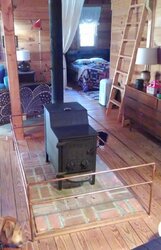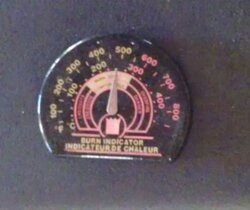Hey All,
Forgive me for my amateur knowledge base, I'm new to wood stoves but really enjoying learning all I can. We recently purchased a small cabin in the northeast Georgia mountains and it had a really nice Fisher wood stove installed. The cabin is only about 1000 sq feet with a loft and a big deck so this stove will run you out if we don't keep it dialed way back. We've used it several times on cold nights and it's amazing, I'd like to learn a bit more about it. I bought a wood stove temp gauge/magnet (see pic below) and am wondering if it's "zones" are accurate for this stove. The Fisher will get really nice and hot showing a surface temp of 800 degrees at times, do I need to stay away from those temps or is that common/OK for this stove?
Also, there is a damper installed on the stovepipe above the stove, can you enlighten me as to the optimal position for controlling the speed of the burn, etc? Usually i keep it tilted at about a 30 degree angle and it seems to slow things down nicely, is this ok? When first starting the fire I open up to completely vertical. I'm also usually only opening one side of the screw style inflow vents about 1/3 turn once the stove gets up to temp.
As you can also see from the pics I built a small "fence" using copper pipe to keep our kidos at a safe distance, we have a 1 yr old and a 3 yr old so keeping tiny fingers away is a must at this stage. It pills apart for the summer and stores easily. Anyway, thanks in advance for any guidance you can offer me on best practiced for keeping the stove working at optimal conditions.
-Jack


Forgive me for my amateur knowledge base, I'm new to wood stoves but really enjoying learning all I can. We recently purchased a small cabin in the northeast Georgia mountains and it had a really nice Fisher wood stove installed. The cabin is only about 1000 sq feet with a loft and a big deck so this stove will run you out if we don't keep it dialed way back. We've used it several times on cold nights and it's amazing, I'd like to learn a bit more about it. I bought a wood stove temp gauge/magnet (see pic below) and am wondering if it's "zones" are accurate for this stove. The Fisher will get really nice and hot showing a surface temp of 800 degrees at times, do I need to stay away from those temps or is that common/OK for this stove?
Also, there is a damper installed on the stovepipe above the stove, can you enlighten me as to the optimal position for controlling the speed of the burn, etc? Usually i keep it tilted at about a 30 degree angle and it seems to slow things down nicely, is this ok? When first starting the fire I open up to completely vertical. I'm also usually only opening one side of the screw style inflow vents about 1/3 turn once the stove gets up to temp.
As you can also see from the pics I built a small "fence" using copper pipe to keep our kidos at a safe distance, we have a 1 yr old and a 3 yr old so keeping tiny fingers away is a must at this stage. It pills apart for the summer and stores easily. Anyway, thanks in advance for any guidance you can offer me on best practiced for keeping the stove working at optimal conditions.
-Jack



